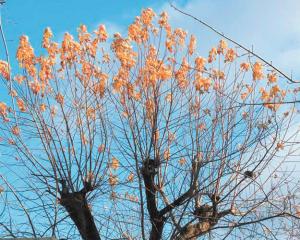Topping damages trees in many important ways
Sometimes we just can't leave well enough alone. Take trees. Trees are planted to provide shade and beauty, to produce nuts and fruits, and traditionally to be valuable for firewood and fenceposts. But once you cut down a tree, it is dead, and it will take years to grow replacements. Hundreds of years ago, people learned that they could periodically cut back trees to ground level, and new sprouts would form a shrub-like collection of small limbs, perfect for fenceposts or firewood. That is known as coppicing. Trees cut back at higher levels are said to be pollarded.
Unfortunately, many homeowners mistakenly think they can cut back the top of a tree and magically make the tree small again. But like a coppiced or pollarded tree, a topped tree will only grow back with a flurry of smaller, weaker limbs, great for firewood, but not so great for hanging on during a storm.
So-called “'tree topping”' on mature trees cuts the upper limbs back to to stubs. Topping damages trees in many important ways. Topping cuts off a lot of the tree's foliage and thus its ability to make its own food, leaving the tree weaker and more prone to disease. It also stimulates the growth of water sprouts: vigorous, dense, unattractive, upright branches often in a hydra-like bundle. This creates a high-maintenance, often dangerous tree needing constant pruning. The topped tree quickly grows back to its original height, only uglier.
Making large cuts to older branches and limbs leaves huge branch wounds that heal slowly, and leave your trees open to decay and insect attacks. The cut stubs cannot get enough food and water flow, and when the tissue dies, the cuts don't seal. Then disease and decay can start, and even spread and kill the tree. Never paint or coat pruning cuts, because it doesn't prevent decay or even promote wound closure.
The weakened limbs and stubs of topped trees break more often in storms. Letting lots of sun into the tree can cause severe bark damage. And worst of all, topping disfigures trees and can actually make your property worth less. The balance between roots and crown is destroyed. Removal of too many branches and leaves can starve trees. Without foliage, trees cannot make enough food to maintain their growth and vigor.
If you need to prune a tree heavily every few years, that tree is simply too big for the site. Rather than endanger your home with weak topped trees, bite the bullet and replant with a tree that will mature at a smaller height.
If you absolutely have to reduce the height of a mature tree, a trained tree specialist might cut it back in a process called drop-crotching. Drop-crotching cuts back on a tree's size but keeps its natural shape. Higher branches are trimmed back to lateral or sideways branches that are at least one-third the diameter of the limbs being cut. The tree specialist needs to cut outside the branch collar at a 45- to 60-degree angle and leave the branch collar intact. This keeps decay from entering the trunk, and this type of cutting stimulates growth throughout the entire tree rather than just at the crown or top.
So, resist the urge to trim back or top full-grown trees. Rather than solving a problem, you may just make matters worse.




















































